Do you have a question about the Samsung SCH-U660 and is the answer not in the manual?
Explains the structure and conventions used within the user manual.
Covers battery installation, charging, and indicator status.
Instructions on how to power the phone on and off.
Explains setting up and listening to voicemail messages.
Guides users through initial phone configuration and preference settings.
Information on enabling and using the phone with TTY devices.
Details on using the phone outside the home network coverage area.
Warns against using unauthorized batteries and chargers.
Step-by-step guide for physically installing the battery into the phone.
Instructions on connecting the charger and charging the device.
Lists key capabilities and technologies of the mobile device.
Explains the functions of external keys and features when the phone is closed.
Identifies and describes the buttons and ports on the phone's sides.
Details the internal keys and their functions when the phone is open.
Explains how to use the directional key for menu navigation and shortcuts.
Describes the function of the left, right, and center select keys.
Explains the usage of Clear Key, Power/End Key, Send Key, and Camera/Camcorder Key.
Describes the main screen layout, status bar, and event status icons.
Details various methods for initiating phone calls.
Explains how to accept or reject incoming calls and handle call waiting.
Describes features available during an active call, like mute and options.
How to terminate an ongoing phone call.
Accessing and viewing the history of dialed, received, and missed calls.
Setting up and initiating a fake incoming call for privacy or convenience.
Configures the phone to prioritize sound alerts for notifications while driving.
Steps to activate the Push-to-Talk service and mode on the device.
Instructions for initiating one-on-one or group Push-to-Talk calls.
Step-by-step process for saving new contact information.
Instructions for deleting single or multiple contacts from the phone.
How to modify existing contact details.
Performing bulk actions like erasing, locking, or copying contacts.
Storing phone numbers with special characters for automated systems.
Methods for searching and locating contacts in the phone's address book.
How to make calls or send messages to contacts.
Information on using the wireless service to back up and restore contacts.
Setting contacts as favorites for quick access to view, message, or call.
Organizing contacts into categories for faster searching and group messaging.
Assigning shortcuts to contacts for quick dialing.
Creating and sending personal contact information as a virtual business card.
Setting up emergency contacts and personal information for assistance.
Sending contact information via message or Bluetooth.
Creating contacts specifically for Push-to-Talk service.
Modifying details of an existing Push-to-Talk contact.
Creating and managing groups for PTT calls.
Switching between different text input methods like T9, Abc, etc.
Using predictive text for faster and easier English word input.
Utilizing predictive text for Spanish word input.
Standard mode for entering text via multi-tap key presses.
Using the 123 mode for numerical text input.
Accessing and inserting common symbols into text fields.
Inserting emoticons into text messages.
Inserting pre-defined phrases or creating custom ones.
Inserting common internet symbols like @ or .com.
Lists the different message formats supported by the phone.
Composing and sending simple text messages (SMS).
Sending messages that include text, pictures, and sound (MMS).
Sending messages with text and video content (MMS).
Composing and sending messages that include voice recordings.
Configuring options for message delivery, display, and storage.
Options for viewing, dismissing, or rejecting incoming messages.
How to read and interact with received text messages.
Accessing and managing received multimedia messages.
How messages are organized and stored within the phone.
Viewing message threads grouped by contact or phone number.
Viewing messages sorted chronologically by date and time.
Accessing and managing outgoing messages.
Reviewing, editing, or sending messages that were not yet sent.
Accessing voicemail messages and managing the counter.
Sending and receiving instant messages using mobile internet.
Updating social media status and accessing accounts from the phone.
Setting up and using the phone to send and receive emails.
Browsing and downloading applications from the V CAST Apps store.
Using the built-in search tool to find local web content.
Accessing the internet using the phone's web browser.
Creating, managing, and playing music and ringtones.
Creating, downloading, and managing pictures and videos.
Using the phone's camera to capture photos.
Customizing camera settings for photo capture.
Detailed configuration options for photo quality, effects, and storage.
Viewing and managing photos stored on the phone or memory card.
Setting up and playing a slideshow of pictures from My Pictures.
Editing photos, applying effects, cropping, and adjusting settings.
Using the phone's camcorder to capture video footage.
Customizing video recording settings like flash, white balance, and effects.
Detailed setup for video quality, audio recording, and auto-naming.
Viewing, managing, and playing video files stored on the device.
Storing and managing pictures in a Verizon Wireless online album.
Accessing the V CAST Apps store to find and download applications.
Using GPS for navigation, directions, and locating points of interest.
Surfing the internet using the phone's built-in web browser.
Using V CAST Media Manager to transfer media between phone and PC.
Playing music transferred from PC or memory card, and managing playlists.
Controlling music playback using on-screen and hardware keys.
Making custom lists of songs to play.
Controlling music playback using external keys when the phone is closed.
Operating the phone using spoken commands for various functions.
Customizing voice command features like readout and sensitivity.
Performing calculations, tip calculations, and unit conversions.
Converting values between different units of measure like temperature and weight.
Scheduling events, setting reminders, and managing appointments.
Setting and managing alarms for various times and frequencies.
Measuring lap times and total elapsed time.
Viewing current times in different time zones around the world.
How to snooze or dismiss an active alarm.
Creating, reading, editing, and erasing text notes.
Connecting the phone to a PC via USB to transfer files.
Finding items like contacts or settings on the phone.
Lists Bluetooth profiles supported by the phone for device interaction.
Instructions for enabling or disabling the Bluetooth feature.
Configuring phone name, visibility, and pairing settings for Bluetooth.
Searching for, pairing with, and connecting to new Bluetooth devices.
Connecting to Verizon Wireless services and managing applications.
Adjusting the overall volume level for ringtones and alerts.
Accessing productivity and information applications like Calculator.
Configuring Push-to-Talk functionality and the PTT/Side Key.
Setting alerts for new Push-to-Talk events.
Configuring notifications for missed Push-to-Talk calls.
Configuring sounds for calls, alerts, key presses, and other actions.
Setting ringtones, vibration patterns, and caller ID readout for incoming calls.
Adjusting sounds and vibration for messages and other alerts.
Setting sounds played when pressing phone keys.
Adjusting the volume level for key press sounds.
Enabling spoken confirmation of numbers as they are dialed.
Configuring sounds for system status changes like ERI, call connect, or updates.
Controlling sounds played when the phone is turned on or off.
Adjusting phone behavior for safer use while driving.
Configuring screen brightness, themes, wallpaper, and menu layout.
Displaying personal greetings or network status banners on the home screen.
Setting the duration and brightness of the display and keypad backlight.
Setting background images for the home and front screens.
Customizing the overall appearance of menus and screens.
Choosing the layout and appearance of the main menu.
Customizing the main menu by replacing items with favorite applications.
Changing the location of menu items within the display.
Restoring menu layout, items, and positions to default settings.
Setting the style and size of characters for the dialer and menus.
Adjusting character sizes for display elements and enabling volume key font adjustment.
Enabling the volume keys to temporarily adjust font size.
Choosing the display format for the main and front clocks.
Setting the clock format and color for the external display.
Adjusting the contrast between fonts and background on the front LCD.
Configuring phone-specific settings like Airplane Mode and shortcuts.
Customizing My Shortcuts and Directional Key shortcuts for quick access.
Assigning favorite applications or features to directional key shortcuts.
Assigning a favorite application or feature to the Side Key shortcut.
Setting a time period for external keys to remain active after closing the phone.
Selecting the display language for the phone's interface.
Choosing whether GPS location is always available or only for emergency calls.
Setting the current country to apply correct dialing codes.
Locking the phone, setting restrictions, and managing security options.
Configuring call, message, and modem usage restrictions.
Defining the phone's locking behavior, such as automatic locking on power up.
Immediately locking the phone to secure it.
Returning all phone settings and data to factory defaults.
Restoring all phone settings to their factory defaults without deleting data.
Setting preferences for data access when outside the home network area.
Configuring roaming behavior, such as home network only or automatic.
Selecting the primary Number Assignment Module for network service.
Information on radio frequency energy exposure from mobile phones.
Details on the phone's compliance with FCC RF exposure limits.
Guidelines for safe mobile device usage while operating a vehicle.
Proper handling, storage, and safety precautions for batteries.
Information on recycling mobile devices and accessories responsibly.
Safety instructions and guidelines for the certified travel charger.
Information on display care, potential damage, and warranty implications.
How the phone uses GPS and AGPS for location-based services.
How location-based information is transmitted and used.
How AGPS assists emergency responders by providing location data.
Using the phone for maps and directions, with caveats on accuracy.
Instructions for making emergency calls and essential safety tips.
Guidelines for cleaning and maintaining the mobile device.
Advice to prevent hearing damage from prolonged exposure to loud audio.
RF exposure and safety recommendations for children's phone usage.
Explains the rating system for mobile device compatibility with hearing aids.
Guidance on preventing children's misuse of the phone.
Warnings about potential interference and compliance with regulations.
General warnings about modifications, accessories, and device handling.
Safety advice for vehicle use, mounting, and storing hazardous materials.
Guidelines for using the device in specific environments and near other electronics.
Safety instructions for using the certified travel charger.
Information on display care, potential damage, and warranty implications.
Explains the phone's use of GPS for location-based services.
Instructions for making emergency calls and essential safety tips.
Guidelines for cleaning and maintaining the mobile device.
Advice to prevent hearing damage from prolonged exposure to loud audio.
RF exposure and safety recommendations for children's phone usage.
Explains the rating system for mobile device compatibility with hearing aids.
Guidance on preventing children's misuse of the phone.
Warnings about potential interference and compliance with regulations.
General warnings about modifications, accessories, and device handling.
Safety advice for vehicle use, mounting, and storing hazardous materials.
Guidelines for using the device in specific environments and near other electronics.
Explains what is covered by the warranty and for how long.
Explains the structure and conventions used within the user manual.
Covers battery installation, charging, and indicator status.
Instructions on how to power the phone on and off.
Explains setting up and listening to voicemail messages.
Guides users through initial phone configuration and preference settings.
Information on enabling and using the phone with TTY devices.
Details on using the phone outside the home network coverage area.
Warns against using unauthorized batteries and chargers.
Step-by-step guide for physically installing the battery into the phone.
Instructions on connecting the charger and charging the device.
Lists key capabilities and technologies of the mobile device.
Explains the functions of external keys and features when the phone is closed.
Identifies and describes the buttons and ports on the phone's sides.
Details the internal keys and their functions when the phone is open.
Explains how to use the directional key for menu navigation and shortcuts.
Describes the function of the left, right, and center select keys.
Explains the usage of Clear Key, Power/End Key, Send Key, and Camera/Camcorder Key.
Describes the main screen layout, status bar, and event status icons.
Details various methods for initiating phone calls.
Explains how to accept or reject incoming calls and handle call waiting.
Describes features available during an active call, like mute and options.
How to terminate an ongoing phone call.
Accessing and viewing the history of dialed, received, and missed calls.
Setting up and initiating a fake incoming call for privacy or convenience.
Configures the phone to prioritize sound alerts for notifications while driving.
Steps to activate the Push-to-Talk service and mode on the device.
Instructions for initiating one-on-one or group Push-to-Talk calls.
Step-by-step process for saving new contact information.
Instructions for deleting single or multiple contacts from the phone.
How to modify existing contact details.
Performing bulk actions like erasing, locking, or copying contacts.
Storing phone numbers with special characters for automated systems.
Methods for searching and locating contacts in the phone's address book.
How to make calls or send messages to contacts.
Information on using the wireless service to back up and restore contacts.
Setting contacts as favorites for quick access to view, message, or call.
Organizing contacts into categories for faster searching and group messaging.
Assigning shortcuts to contacts for quick dialing.
Creating and sending personal contact information as a virtual business card.
Setting up emergency contacts and personal information for assistance.
Sending contact information via message or Bluetooth.
Creating contacts specifically for Push-to-Talk service.
Modifying details of an existing Push-to-Talk contact.
Creating and managing groups for PTT calls.
Switching between different text input methods like T9, Abc, etc.
Using predictive text for faster and easier English word input.
Utilizing predictive text for Spanish word input.
Standard mode for entering text via multi-tap key presses.
Using the 123 mode for numerical text input.
Accessing and inserting common symbols into text fields.
Inserting emoticons into text messages.
Inserting pre-defined phrases or creating custom ones.
Inserting common internet symbols like @ or .com.
Lists the different message formats supported by the phone.
Composing and sending simple text messages (SMS).
Sending messages that include text, pictures, and sound (MMS).
Sending messages with text and video content (MMS).
Composing and sending messages that include voice recordings.
Configuring options for message delivery, display, and storage.
Options for viewing, dismissing, or rejecting incoming messages.
How to read and interact with received text messages.
Accessing and managing received multimedia messages.
How messages are organized and stored within the phone.
Viewing message threads grouped by contact or phone number.
Viewing messages sorted chronologically by date and time.
Accessing and managing outgoing messages.
Reviewing, editing, or sending messages that were not yet sent.
Accessing voicemail messages and managing the counter.
Sending and receiving instant messages using mobile internet.
Updating social media status and accessing accounts from the phone.
Setting up and using the phone to send and receive emails.
Browsing and downloading applications from the V CAST Apps store.
Using the built-in search tool to find local web content.
Accessing the internet using the phone's web browser.
Creating, managing, and playing music and ringtones.
Creating, downloading, and managing pictures and videos.
Using the phone's camera to capture photos.
Customizing camera settings for photo capture.
Detailed configuration options for photo quality, effects, and storage.
Viewing and managing photos stored on the phone or memory card.
Setting up and playing a slideshow of pictures from My Pictures.
Editing photos, applying effects, cropping, and adjusting settings.
Using the phone's camcorder to capture video footage.
Customizing video recording settings like flash, white balance, and effects.
Detailed setup for video quality, audio recording, and auto-naming.
Viewing, managing, and playing video files stored on the device.
Storing and managing pictures in a Verizon Wireless online album.
Accessing the V CAST Apps store to find and download applications.
Using GPS for navigation, directions, and locating points of interest.
Surfing the internet using the phone's built-in web browser.
Using V CAST Media Manager to transfer media between phone and PC.
Playing music transferred from PC or memory card, and managing playlists.
Controlling music playback using on-screen and hardware keys.
Making custom lists of songs to play.
Controlling music playback using external keys when the phone is closed.
Operating the phone using spoken commands for various functions.
Customizing voice command features like readout and sensitivity.
Performing calculations, tip calculations, and unit conversions.
Converting values between different units of measure like temperature and weight.
Scheduling events, setting reminders, and managing appointments.
Setting and managing alarms for various times and frequencies.
Measuring lap times and total elapsed time.
Viewing current times in different time zones around the world.
How to snooze or dismiss an active alarm.
Creating, reading, editing, and erasing text notes.
Connecting the phone to a PC via USB to transfer files.
Finding items like contacts or settings on the phone.
Lists Bluetooth profiles supported by the phone for device interaction.
Instructions for enabling or disabling the Bluetooth feature.
Configuring phone name, visibility, and pairing settings for Bluetooth.
Searching for, pairing with, and connecting to new Bluetooth devices.
Connecting to Verizon Wireless services and managing applications.
Adjusting the overall volume level for ringtones and alerts.
Accessing productivity and information applications like Calculator.
Configuring Push-to-Talk functionality and the PTT/Side Key.
Setting alerts for new Push-to-Talk events.
Configuring notifications for missed Push-to-Talk calls.
Configuring sounds for calls, alerts, key presses, and other actions.
Setting ringtones, vibration patterns, and caller ID readout for incoming calls.
Adjusting sounds and vibration for messages and other alerts.
Setting sounds played when pressing phone keys.
Adjusting the volume level for key press sounds.
Enabling spoken confirmation of numbers as they are dialed.
Configuring sounds for system status changes like ERI, call connect, or updates.
Controlling sounds played when the phone is turned on or off.
Adjusting phone behavior for safer use while driving.
Configuring screen brightness, themes, wallpaper, and menu layout.
Displaying personal greetings or network status banners on the home screen.
Setting the duration and brightness of the display and keypad backlight.
Setting background images for the home and front screens.
Customizing the overall appearance of menus and screens.
Choosing the layout and appearance of the main menu.
Customizing the main menu by replacing items with favorite applications.
Changing the location of menu items within the display.
Restoring menu layout, items, and positions to default settings.
Setting the style and size of characters for the dialer and menus.
Adjusting character sizes for display elements and enabling volume key font adjustment.
Enabling the volume keys to temporarily adjust font size.
Choosing the display format for the main and front clocks.
Setting the clock format and color for the external display.
Adjusting the contrast between fonts and background on the front LCD.
Configuring phone-specific settings like Airplane Mode and shortcuts.
Customizing My Shortcuts and Directional Key shortcuts for quick access.
Assigning favorite applications or features to directional key shortcuts.
Assigning a favorite application or feature to the Side Key shortcut.
Setting a time period for external keys to remain active after closing the phone.
Selecting the display language for the phone's interface.
Choosing whether GPS location is always available or only for emergency calls.
Setting the current country to apply correct dialing codes.
Locking the phone, setting restrictions, and managing security options.
Configuring call, message, and modem usage restrictions.
Defining the phone's locking behavior, such as automatic locking on power up.
Immediately locking the phone to secure it.
Returning all phone settings and data to factory defaults.
Restoring all phone settings to their factory defaults without deleting data.
Setting preferences for data access when outside the home network area.
Configuring roaming behavior, such as home network only or automatic.
Selecting the primary Number Assignment Module for network service.
Information on radio frequency energy exposure from mobile phones.
Details on the phone's compliance with FCC RF exposure limits.
Guidelines for safe mobile device usage while operating a vehicle.
Proper handling, storage, and safety precautions for batteries.
Information on recycling mobile devices and accessories responsibly.
Safety instructions and guidelines for the certified travel charger.
Information on display care, potential damage, and warranty implications.
How the phone uses GPS and AGPS for location-based services.
How location-based information is transmitted and used.
How AGPS assists emergency responders by providing location data.
Using the phone for maps and directions, with caveats on accuracy.
Instructions for making emergency calls and essential safety tips.
Guidelines for cleaning and maintaining the mobile device.
Advice to prevent hearing damage from prolonged exposure to loud audio.
RF exposure and safety recommendations for children's phone usage.
Explains the rating system for mobile device compatibility with hearing aids.
Guidance on preventing children's misuse of the phone.
Warnings about potential interference and compliance with regulations.
General warnings about modifications, accessories, and device handling.
Safety advice for vehicle use, mounting, and storing hazardous materials.
Guidelines for using the device in specific environments and near other electronics.
Safety instructions for using the certified travel charger.
Information on display care, potential damage, and warranty implications.
Explains the phone's use of GPS for location-based services.
Instructions for making emergency calls and essential safety tips.
Guidelines for cleaning and maintaining the mobile device.
Advice to prevent hearing damage from prolonged exposure to loud audio.
RF exposure and safety recommendations for children's phone usage.
Explains the rating system for mobile device compatibility with hearing aids.
Guidance on preventing children's misuse of the phone.
Warnings about potential interference and compliance with regulations.
General warnings about modifications, accessories, and device handling.
Safety advice for vehicle use, mounting, and storing hazardous materials.
Guidelines for using the device in specific environments and near other electronics.
Explains what is covered by the warranty and for how long.
| Model | Samsung SCH-U660 |
|---|---|
| Network Technology | CDMA |
| 2G bands | CDMA 800 / 1900 |
| Status | Discontinued |
| SIM | Mini-SIM |
| Display Type | TFT, 256K colors |
| Display Size | 2.2 inches |
| Resolution | 176 x 220 pixels |
| Call records | Yes |
| Camera | 1.3 MP |
| Alert types | Vibration; Downloadable polyphonic, MP3 ringtones |
| Loudspeaker | Yes |
| 3.5mm jack | No |
| WLAN | No |
| GPS | No |
| Radio | No |
| Browser | WAP 2.0/xHTML |
| Games | Yes |
| Java | Yes, MIDP 2.0 |
| Stand-by | Up to 300 h |
| Talk time | Up to 5 h |
| Operating System | Proprietary |
| Memory Card slot | microSD |
| Phonebook | 1000 entries |
| Bluetooth | 2.0 |
| USB | Yes |
| Messaging | SMS, MMS |
| Battery | Removable Li-Ion 900 mAh battery |
| Colors | Black |

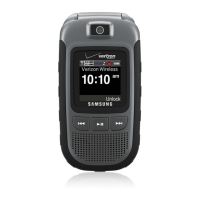


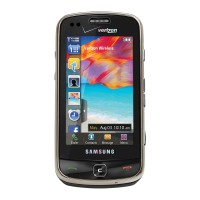
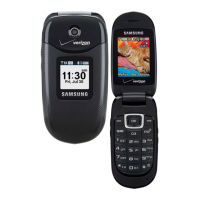
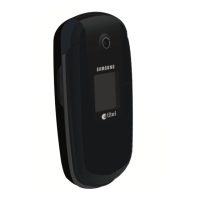
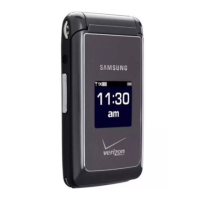
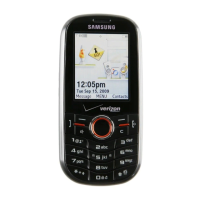

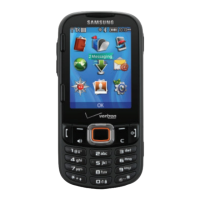

